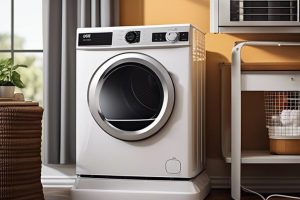What size generator do I need to run a dryer?

In the realm of emergency power sources, selecting the appropriate generator size is crucial to ensure your appliances function efficiently. When it comes to running a dryer off a generator, factors such as wattage requirements, startup energy surges, and fuel types all play a vital role. This guide aims to provide clear and concise information on determining the right generator size to power your dryer effectively.
Key Takeaways:
- Dryer Power Requirement: Check the manufacturer’s specifications to determine the power consumption of your dryer in watts or amps.
- Generator Capacity: Choose a generator with a rated wattage higher than the power requirement of your dryer to ensure it can run without overloading the generator.
- Consider Starting Wattage: Factor in the starting wattage, which is typically higher than the running wattage, when selecting a generator to start and run the dryer smoothly.
Types of Generators
Any household looking to power their dryer with a generator will need to consider the different types of generators available on the market. Each type has its own advantages and considerations to keep in mind. Let’s delve into the key types of generators below:
| 1. Portable Generators | 2. Standby Generators |
| 3. Inverter Generators | 4. Solar Generators |
| 5. Wind Generators |
One popular option for powering a dryer is a portable generator. Portable generators are versatile and can be moved around to different locations as needed. They are usually fueled by gasoline or propane and come in various sizes to accommodate different power needs. When using a portable generator for your dryer, remember to place it in a well-ventilated area outside and follow all safety precautions.
Generators that fall under the category of standby generators are typically larger and more permanent installations. Standby generators are often connected directly to a home’s electrical system and can automatically start up during a power outage. They are usually fueled by natural gas or propane and are capable of powering multiple appliances, including dryers. Standby generators provide a seamless transition to backup power and offer peace of mind during extended outages.
Standby Generators
Standby generators are a reliable and efficient way to ensure your home stays powered during emergencies. These generators are installed outside the home and can kick in automatically when the main power supply fails. The installation of a standby generator typically requires a professional electrician to ensure proper setup and connectivity to the home’s electrical system. Standby generators are an investment in your home’s resilience and can provide long-term backup power solutions.
Factors to Consider When Selecting a Generator Size
Some of the key factors to consider when selecting the appropriate generator size to run a dryer include the power requirements of the dryer, the starting wattage, the running wattage, and any additional power considerations in your home.
- Understanding the power requirements of the dryer
- Evaluating the starting and running wattage of the dryer
- Taking into account any other power needs in your home
The size of the generator you choose will ultimately depend on these factors and ensuring that you have enough power to safely and effectively run your dryer during a power outage.
Understanding Dryer Specifications
Consider the power requirements of your dryer, which can typically be found on the appliance label or in the user manual. This information will help you determine the amount of wattage needed to run your dryer smoothly.
It is essential to know both the starting wattage, which is higher as the appliance powers on, and the running wattage, which is the continuous power needed to keep the dryer running. These values will guide you in selecting the right generator size for your needs.
Additional Power Considerations in Your Home
Home generators should not only meet the power requirements of your dryer but also consider other essential appliances and devices that may need to run during a power outage. Items such as refrigerators, lighting, and heating systems should be factored into your overall power needs.
The size of the generator you choose should be able to accommodate all these power requirements simultaneously to ensure that you can maintain a comfortable and safe living environment during any power disruptions.
Step-by-Step Guide to Determining the Right Generator Size
Despite power outages, having a generator that can support your essential appliances can provide peace of mind. When it comes to running a dryer during a power outage, determining the right generator size is crucial to ensure that your laundry routine doesn’t come to a halt. Let’s walk through the steps to help you figure out what size generator you need to run your dryer.
| Calculating Dryer Wattage Requirements | Accounting for Starting and Running Watts |
|---|
Calculating Dryer Wattage Requirements
On the first step of determining the right generator size for your dryer, you need to calculate the wattage requirements of your specific dryer model. This information can typically be found on the dryer’s nameplate or in the user manual. The wattage rating will give you the power consumption of your dryer when it’s in operation.
On the next step, consider any additional features or settings your dryer may have that could impact its power usage. For example, if your dryer has a sensor drying feature or a steam option, these may require extra power. Make sure to account for these additional wattage demands to get an accurate picture of your generator size needs.
Accounting for Starting and Running Watts
Any electric motor-driven appliance like a dryer requires more power to start up (starting watts) than it does to keep running (running watts). When choosing a generator size, you need to consider both the starting watts and running watts of your dryer to ensure that the generator can handle the initial power surge and continuous operation. Failure to account for starting watts could lead to overload and damage to the generator.
For instance, a typical dryer may have a running wattage of around 1800 watts but require up to 5000 watts to start up. In this case, you would need a generator with a starting wattage capacity of at least 5000 watts to safely run your dryer. Understanding and accounting for these different power requirements is essential in selecting the right generator size for your specific needs.
Tips for Generator Usage with a Dryer
For those looking to use a generator to power their dryer during a power outage or off-grid living, there are a few key tips to keep in mind to ensure smooth operation and safety.
- Ensure the generator has a wattage capacity that is suitable for powering your dryer. Consult the dryer’s manual or contact the manufacturer for specific power requirements.
- Use a heavy-duty extension cord to connect the dryer to the generator to prevent overheating and ensure a stable power supply.
- Place the generator outdoors in a well-ventilated area to avoid carbon monoxide buildup. Never operate a generator indoors or in an enclosed space.
- Regularly refuel the generator with the recommended fuel type and never overload it with appliances beyond its capacity.
Knowing the ins and outs of using a generator with a dryer can help prevent accidents and ensure the longevity of both your appliances.
Safety Precautions
Generator safety is crucial when using it to power a dryer. Always follow the manufacturer’s guidelines for operation, including proper ventilation and fueling. Also, make sure to keep the generator away from flammable materials and never operate it in wet conditions.
It’s essential to install a carbon monoxide detector near the dryer area when using a generator to monitor levels and ensure your safety. Additionally, never attempt to refuel the generator while it is running or hot to prevent accidental fires.
Maintenance and Care for Longevity
To prolong the life of your generator and dryer when used together, it’s important to perform regular maintenance. This includes checking the oil levels, air filters, and spark plugs of the generator to ensure optimal performance.
To prevent any damage to the dryer, make sure to clean the lint trap after every use and inspect the venting system for any blockages. This will not only help maintain the efficiency of the dryer but also reduce the risk of fire hazards.
To further protect your appliances and generator, consider investing in surge protectors to prevent electrical damage during power fluctuations. This simple addition can go a long way in ensuring the longevity of your devices.
Dryer maintenance is just as important as generator care when using them together. Cleaning the dryer vent regularly and scheduling professional dryer vent cleanings can prevent lint buildup and reduce the risk of fires.
Pros and Cons of Different Generator Sizes
To properly power a dryer, you need to ensure your generator size matches the requirements of the appliance. Here we will discuss the pros and cons of different generator sizes to help you make an informed decision.
Pros of Adequate Sizing
Adequate sizing is essential to ensure your generator can handle the load of the dryer without strain. By selecting the right size generator, you can effectively power your dryer and other essential appliances during power outages. This ensures your comfort and convenience are maintained even during emergencies.
Cons of Oversizing or Undersizing
Undersizing your generator can lead to it being overwhelmed by the power requirements of the dryer, resulting in inefficiency or even damage to the appliance. On the other hand, oversizing a generator can lead to wasted energy and increased fuel consumption, especially if the generator is not being used to its full capacity.
Cons of Oversizing or Undersizing can also lead to increased maintenance costs and a shorter lifespan for the generator. It is crucial to match the generator size to the specific power requirements of your dryer to avoid these issues.
Hence, determining the size of the generator needed to run a dryer is crucial for ensuring its proper functioning during power outages. By calculating the starting watts and running watts of the dryer and selecting a generator with sufficient capacity, you can efficiently power your dryer when needed. It is always recommended to consult the dryer manufacturer’s specifications and seek professional advice to determine the right generator size for your specific needs. Making an informed decision will help you avoid electrical problems and ensure a seamless backup power solution for your dryer.
FAQ
Q: What size generator do I need to run a dryer?
A: To run a standard electric clothes dryer, you will need a generator with a minimum power output of 5000 watts. It’s important to check the specific power requirements of your dryer model to ensure the generator can handle the load.
Q: Can I use a portable generator to run a dryer?
A: Yes, you can use a portable generator to run a dryer, but it’s crucial to select a generator with sufficient wattage and the appropriate outlets for your dryer’s power cord. Make sure to follow all safety guidelines and never run a generator indoors.
Q: What are the risks of using an undersized generator for a dryer?
A: Using an undersized generator to run a dryer can lead to overheating, electrical hazards, and damage to both the generator and the dryer. It’s essential to match the generator’s power output to the dryer’s requirements to prevent potential safety issues and equipment damage.
